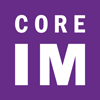Core IM
This episode on Heart Failure with Reduced Ejection Fraction (HFrEF) GDMT (Guideline-directed medical therapy) further expands on the considerations and guidelines for medical management of HFrEF. With the new results from clinical trials and major guideline updates, a detailed explanation is needed to address medications recommended only in specific subsets of patients such as ivabradine or hydralazine and in diverse and commonly encountered circumstances such as heart failure treatment in the setting of chronic kidney disease, inpatient vs. outpatient setting. Additionally, the team will discuss the expected recovery of the ejection fraction with appropriate GDMT along with many practical pearls for practicing internists.
You’re invited to join Core IM as they explore Guideline-Directed Medical Therapy part II: 5 Pearls Segment.
First, listen to the podcast. After listening, ACP members can take the CME/MOC quiz for free.
CME/MOC:
Up to 0.5
AMA PRA Category 1 Credits ™ and MOC Points
Expires September 19, 2026
active
Cost:
Free to Members
Format:
Podcasts and Audio Content
Product:
Core IM
Welcome to Core IM, a virtual medical community! Core IM strives to empower its colleagues of all levels and backgrounds with clinically applicable information as well as inspire curiosity and critical thinking. Core IM promotes its mission through podcasts and other multimodal dialogues. ACP has teamed up with Core IM to offer continuing medical education, available exclusively to ACP members by completing the CME/MOC quiz.

Pearl 1: Quadruple-therapy in CKD
- There are four medications used in Guideline-Directed Medical Therapy (GDMT) for HFrEF:
- Beta-blocker
- ACE, ARB, ARNI
- MRA
- SGLT-2 Inhibitor
What additional considerations are warranted when using these medications for patients with CKD? for patients with CKD?
-
- Beta blockers:
- Should be considered in all patients with HFrEF regardless of kidney function.
- However, may have be limited by orthostasis and other side effects (e.g dizziness)
- Should be considered in all patients with HFrEF regardless of kidney function.
- ACE inhibitors, ARBs, and ARNIs:
- May cause a temporary increase in creatinine (~30%)
- Long-term nephroprotective effects
- There is no absolute creatinine-based contraindication to initiation
- Subsequent dose-adjustment may be required based on follow-up:
- Blood pressure
- Potassium levels
- Consider potassium binders if necessary (check out our episode on hyperkalemia in CKD)
- May cause a temporary increase in creatinine (~30%)
- Mineralocorticoid antagonists (MRAs):
- If Creatinine > 2.5 mg/dl, avoid initiating an MRA, but do not discontinue if they patient is already on it as CKD progresses
- SGLT2 inhibitors:
- If GFR < 20, don not initiate SGLT2i therapy, but may be ok to continue
- PRACTICAL TIP! Starting SGLT2 inhibitors and MRAs together may provide a buffer against hyperkalemia.
- Beta blockers:
- As CKD progresses to stage 3, using these medications becomes increasingly challenging!
- However, these medications slow the decline in kidney function even at advanced stages!
- As long as the patient is not experiencing side effects, it is ok to continue these medications in CKD Stage 4 or even 5
- Evidence supports the nephroprotective and beneficial cardiovascular effects of these medications independent of creatinine
- However, these medications slow the decline in kidney function even at advanced stages!
- Consider the difference between initiating and continuing a medication:
- Initiating:
- Uncertainty about how a patient will respond to a new drug and whether it will be well-tolerated.
- Continuing:
- Patient already demonstrated they can tolerate that agent in the long-term and doses can be adjusted if adverse effects occur
- Always keep therapeutic inertia in mind, which can manifest in both continuing effective medications and hesitating to initiate new ones
- Initiating:
Pearl 2: Hydralazine/Isosorbide Dinitrate
- Pathophysiology:
- Vasodilators
- Reduce peripheral resistance → Lower blood pressure
- Vasodilators
- Outcomes and trial data:
- V-HeFT trial (1986)
- Trend towards improved survival among patients with systolic heart failure who were treated with hydralazine and isosorbide dinitrate
- A-HeFT trial (2004)
- Combination of hydralazine and isosorbide dinitrate improve survival and reduce hospitalization among black patients with HFrEF
- V-HeFT II Trial
- Enalapril had a more favorable effect on 2-year survival than a combination of hydralazine plus isosorbide dinitrate.
- Hydralazine and isosorbide dinitrate can be considered if:
- Initiation of first-line therapy (ACE-I, ARB, or ARNI) is contraindicated
- Drug intolerance Renal insufficiency)
- Blood pressure goals are not met on first-line therapy alone
- Initiation of first-line therapy (ACE-I, ARB, or ARNI) is contraindicated
- Current guidelines recommend initiation for self-identified African American patients who are otherwise receiving optimal medical therapy to:
- Improve symptoms
- Reduce morbidity and mortality.
- V-HeFT trial (1986)
- Patient Counseling:
- Vasodilatory effects can lead to headaches
- Require 3 times daily dosing
- Short half-lives
- Lab monitoring is NOT required
- Do not affect renal function
- Pro tips:
- If caring for a patient on hydralazine/isosorbide dinitrate, always look back at the chart to investigate the reason they are not on preferred first line agents and continually re-evaluate!
Pearl 3: Ivabradine
- Pathophysiology:
- Lowers HR
- Selectively inhibits cardiac pacemaker current called the “funny channel”
- “Funny channel” controls the spontaneous diastolic depolarization in the SA node
- Selectively inhibits cardiac pacemaker current called the “funny channel”
- Lowers HR
- Outcomes and trial data:
- SHIFT Trial
- Addition of ivabradine to patients who had a resting HR >/ 70 bpm despite maximal beta blockade → reduced rates of hospitalization
- SHIFT Trial
- Patient Counseling:
- Start only if the patient is on maximally tolerated doses of beta blockers
- Does not affect blood pressure or kidney function
- Pro tips:
- Lower the heart rate, the better the outcome!
- Patients must be in sinus rhythm for this med!
- Can't be in afib, flutter, and should not have pre-existing conduction abnormalities
Pearl 4: Inpatient vs Outpatient Considerations
- 1 in 4 annual cardiovascular deaths are due to heart failure
- CHAMP-HF registry (2016-2018):
- ONLY 1% of eligible patients were simultaneously on target doses of ACEi/ARB/ARNI, BB, and MRA therapy
- Safety, Tolerability and efficacy of Rapid Optimization (STRONG-HF Trial):
- There is no substantial overlap in effect of the GDMT meds, thus it is important to utilize each in combination!
Pearl 5: Patient Expectations on EF Recovery
- Patients with heart failure with improved ejection fraction may have:
- Complete recovery of LVEF (EF >/50%)
- Partial recovery of LVEF (EF 40-50%)
- No recovery of LVEF (EF <40%)
- Estimates of the proportion of patients with improved LVEF range widely (e.g., 10% to 40%)
- This is due to:
- Variable definitions
- Use of both observational and clinical trial datasets
- This is due to:
- The HIGHEST rates of EF recovery in:
-
- Tachycardia induced cardiomyopathy those caused by
- Hypo or hyperthyroidism induced cardiomyopathy
- Make sure to fully investigate the underlying cause of the cardiomyopathy in order to improve chances of recovery of EF!
-
- The SECOND HIGHEST rates of EF recovery:
- Dilated cardiomyopathies that are associated with immune responses
- Peripartum cardiomyopathy
- Viral myocarditis
- Systemic inflammatory response syndrome
- Dilated cardiomyopathies that are associated with immune responses
- According to the 2022 ACC/AHA guidelines, GDMT for HFrEF should be continued even when EF improves or fully recovers– a state now called Heart Failure with improved Ejection Fraction (HFimpEF)
- Data has shown that even among patients whose ejection fraction fully recovers, a large portion will develop recurrent LV dysfunction and heart failure events
Contributors
Shreya Trivedi, MD, ACP Member - Host / Editor
Aaron Troy, MD - Editor
Viktoria Mladenovik, MD - Editor, Host
Santiago Callegari, MD - Editor
Sweta Motiwala, MD* - Guest Discussant
Greg Katz, MD - Guest Discussant
Reviewers
Randal Goldberg, MD
Susan McIlvaine, MD
*Sweta Motiwala, MD
End Point Review Committee - Abbott Labs
Those named above, unless otherwise indicated, have no relevant financial relationships to disclose with ineligible companies whose primary business is producing, marketing, selling, re-selling, or distributing healthcare products used by or on patients. All relevant relationships have been mitigated.
Release Date: September 20, 2023
Expiration Date: September 19, 2026
CME Credit
This activity has been planned and implemented in accordance with the accreditation requirements and policies of the Accreditation Council for Continuing Medical Education (ACCME) through the joint providership of the American College of Physicians and Core IM. The American College of Physicians is accredited by the ACCME to provide continuing medical education for physicians.
The American College of Physicians designates this enduring material (podcast) for .5 AMA PRA Category 1 Credit™. Physicians should claim only the credit commensurate with the extent of their participation in the activity.
ABIM Maintenance of Certification (MOC) Points
Successful completion of this CME activity, which includes participation in the evaluation component, enables the participant to earn up to .5 medical knowledge MOC Point in the American Board of Internal Medicine’s (ABIM) Maintenance of Certification (MOC) program. Participants will earn MOC points equivalent to the amount of CME credits claimed for the activity. It is the CME activity provider’s responsibility to submit participant completion information to ACCME for the purpose of granting ABIM MOC credit.
How to Claim CME Credit and MOC Points
After listening to the podcast, complete a brief multiple-choice question quiz. To claim CME credit and MOC points you must achieve a minimum passing score of 66%. You may take the quiz multiple times to achieve a passing score.


